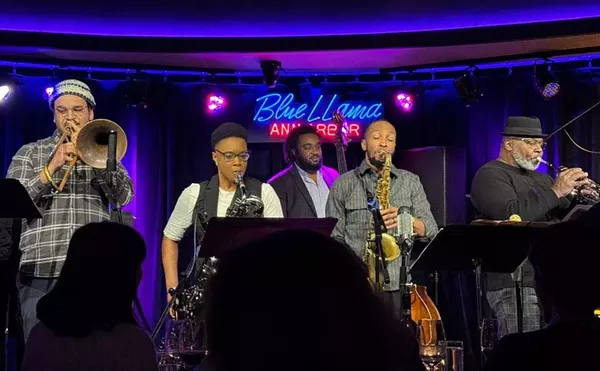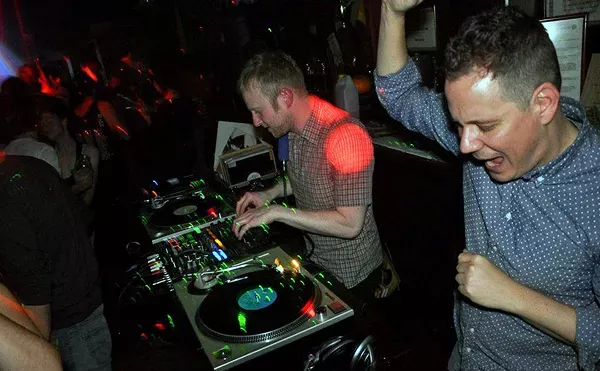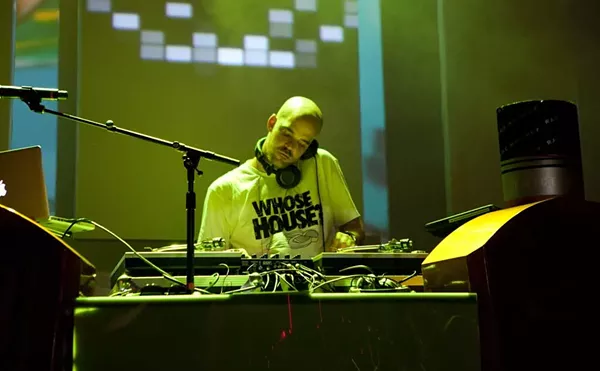It is absolutely beyond cliché to read about bands splitting up due to “creative differences.” Egos collide. Personalities clash. The drummer always wants more respect (yeah, right!).
The mirror of that cliché, of course, is the one-man band — the tortured studio auteur tweaking the reverb on guitar overdubs well past dawn in search of the perfect sound. This is the lonely musical road to such adjectives as “legendary,” “critically acclaimed” and “commercially ignored.”
When you layer into this matrix such prefab TV pop music phenomena as the car-crash-fascinating “Popstars” and “Making the Band,” it’s hard to deny that creating, sustaining and just being in a band these days ain’t as simple as the old four-fellas-in-a-garage fairy tale has taught us.
Thing is, there’s a way out of these traps that 50 years of the “boys in the band” paradigm hasn’t been able to illuminate. The human behind that bit of innovative, future-forward thinking is Olympia, Wash., performance artist Wynne Greenwood and her nom de guerre, Tracy + the Plastics.
Tracy + the Plastics are, to put it simply, a synthesizer-based indie-pop band disguised as a video art event — or is it the other way around? The music is a bouncy, punky, agitated confection of lo-fi synth melodies and beats under detached, queer-positive New-Wave/no-wave-posturing lyrics.
Greenwood is responsible for all of these sounds as found on the band’s debut full-length Muscler’s Guide to Videonics (Chainsaw Records). But for the live shows, she has created two cohorts — Niki, keyboards and sampler, and Cola, drum machine — who participate and interact via the miracle of a life-size VHS projection while Tracy takes center stage singing, dancing and bantering live with the crowd and her band mates.
“Tracy + the Plastics started in the fall of 1999 as the plot and sound track for a murder-mystery video I was making,” Greenwood explains via e-mail.
“Well, thinking of making. It was more exciting to translate the characters and songs into a band.”
If necessity is the mother of invention, Tracy + the Plastics are the black sheep of the family. But they’re part of a lineage that includes sisters, aunts and cousins such as Yoko Ono, the Fall, Josie and the Pussycats, Roberto del Rosario (inventor of the karaoke machine), Sleater-Kinney, Kenneth Anger, Laurie Anderson, and other long-lost relatives. Tracy + the Plastics are also of a piece with a post-punk DIY electro-pop moment happening simultaneously for such outfits as Kathleen Hanna’s most recent incarnation, Le Tigre and the wonderfully hard-to-peg trio, the Need. Yet none of them have hard-coded the multimedia and character-driven aspects of their rock performances into the band DNA quite like Greenwood has.
Who are these gals?
When asked to describe the players in her band, Greenwood tosses off seemingly casual one-liners that are as wittily cryptic as they are revealing.
“Niki: An artist type who keeps starting to read Walter Benjamin’s The Work of Art in the Age of Mechanical Reproduction. Cola: Used to smoke a lot of weed and then got political. Tracy: Just trying to keep her balance up there.”
Greenwood has obviously been working with and embodying these characters long enough to give them room to evolve. She’s quick to add that “of course there’s more to them than [that], but those would be the caption under the picture.
“Anyway, their personalities are constantly filling in. There is an outline drawn — if even just by their names — that is slowly colored, traced, blackened, dimensionalized by their movements, actions, interaction, words, outfits, etc. Of course, when I’m tired, I want them all to go away.
“Nikki and Cola have gotten really good responses and even been asked on dates. Unfortunately, they don’t date,” says Greenwood on behalf of her band mates. “In fact, they have a club called D-D-DAM. It stands for “Don’t Date, Don’t Ask, Motherf---er.”
This is not the first time Greenwood has put character first. She had previously been in the “video band” MeMe America with Sally Scardino.
“MeMe America also began as a character — a young woman whose heart was failing, so she began to sew her own version,’ says Greenwood.
“It turned into an experiment in audio/visual storytelling. We would make up music to videos I made and then play it all live. The video was the focus, we backed it up.”
Tracy + the Plastics flips that particular script, letting the video play “backup.” But live, the interaction between the women is the kind of banter you would expect from rock band mates who’ve been on the road with one another for a bit too long. It provides the human foil to Tracy’s rapid-fire lyrics of acute-angled agit-prop poetics and the mechanized beats over which they are delivered. Whether it’s rehearsed or not (and by nature it must be), it feels spontaneous.
An audience watching a woman talk to a movie screen projecting images of her vaguely doppelgängerish band mates blows away the theatrical concept of breaking through the “fourth wall” (in which the actor enters the world of the audience in character and thus draws them in deeper to the suspension of disbelief).
Greenwood describes the live Tracy + the Plastics experience more simply: “Hopefully the music will be really loud and you’ll feel like you’re in a basement art party with your closest friends all posturing around you, vying for the attention of the drumbeats you can’t hear fast enough.”
Seeing and believing
The intended effect is to suck you in to a dialogue with yourself about the act of “watching” a band. Think about the last time you went to a show. Did you describe it as “I went and heard so and so” or did you say “I went and saw so and so.”
With Tracy + the Plastics, there’s just no difference, semantic or otherwise.
“You will learn to talk the same talk as this specific medium, video, and take those words home with you to stump the TV when it tries to tell you to explain yourself,” explains Greenwood.
But how do people react to a barrage of conceptual art disguised as simple, danceable tunes.
“People like it,” says Greenwood. “It sucks when they say it’s cute or take it as a joke, but then again I do like jokes and I’ll be the first to laugh at myself and I do know how to spell absurd. So …
“Someone asked me once whether Niki and Cola ever came on tour with me for real.”
It’s an elegantly economic and infinitely artful solution to the age-old problem of interpersonal band squabbling and creative entropy. To crib from Devo’s de-evolutionary war cry, “Jocko Homo”: “We must repeat.”
Tracy + the Plastics appear for a free performance at the College for Creative Studies on Friday, March 22, at 7pm. Check out the Metro Times' online events calendar for more details.
Chris Handyside is a freelance writer for Metro Times. Send comments to [email protected]





